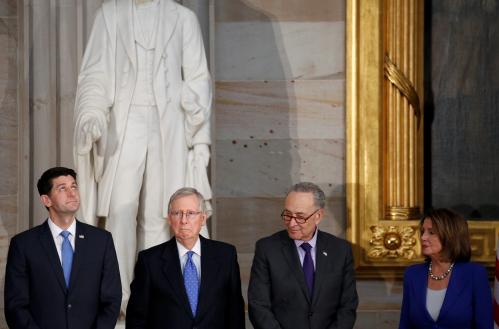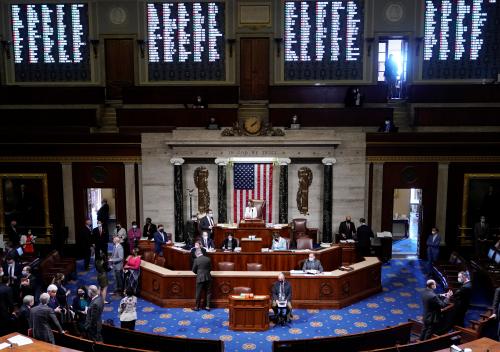This blog post originally appeared on the Lawfare blog.
The House of Representatives was supposed to return to Capitol Hill on Monday, May 4, after a lengthy recess interrupted sporadically by brief returns to vote on coronavirus-related relief bills. But on April 28, House Majority Leader Steny Hoyer announced that the House would not be reconvening as planned. His decision followed the recommendation of Congress’s attending physician, Brian Monahan, who warned against recalling members of Congress in light of worsening numbers of coronavirus infections in Washington, D.C.
Hoyer’s decision may have been wise from a public health perspective, but it puts the House in a difficult position. Under current House and Senate rules, neither chamber, nor their various committees, can vote or go about their other work while members are not physically present in the Capitol. This appears to be why Senate Majority Leader Mitch McConnell reconvened the Senate on May 4, despite Monahan’s warnings.
Despite these challenges, Congress has passed substantial legislation to address the pandemic—and is enjoying improved public approval ratings as a result. But its ability to do so is rapidly approaching an inflection point. Broad rank-and-file support for bills negotiated almost exclusively by Senate and House leadership is dwindling as members of Congress voice diverging views on the next appropriate step in addressing the pandemic. Nor is it clear how much longer Congress can wait to engage in other essential legislative work, given that the pandemic seems likely to continue for several more months.
Consensus appears to be growing in both the House and the Senate that some form of temporary remote work is the clearest solution to this problem. Yet congressional leaders have resisted. In the Senate, McConnell has continued to oppose remote-voting proposals even as he’s pushed forward with reconvening in spite of Monahan’s warning. Meanwhile, in the House, Republican leaders have pushed back against efforts by Speaker Nancy Pelosi to move toward remote voting. If Congress can’t resolve this problem, the results could be debilitating.
Steps in the Right Direction
Congress’s need for some sort of remote-voting capability is not a new issue. Since the outbreak of the coronavirus crisis, outside voices—including both of us—have urged Congress to adopt rules that will allow it to perform at least its most essential functions at a distance. Both Democratic and Republican legislators in both chambers took up these calls, introducing proposed rules changes and petitioning their leaders on the issue. Yet congressional leaders proved resistant to such changes. McConnell expressed confidence that coronavirus risks could be managed adequately by limiting floor time, reducing the number of senators on the floor and other minor procedural modifications. Pelosi initially adopted a similar stance but ultimately referred the issue to the House Rules Committee for further consideration after coming under pressure from her caucus. In late March, that committee’s majority staff produced a report that seemed to echo many of the reservations that some had voiced about remote voting. These include concerns that remote voting would be vulnerable to external monitoring or manipulation, among other cybersecurity vulnerabilities, and that allowing Congress to enact legislation while not physically present might be inconsistent with constitutional quorum requirements and thus ultimately invalidated by the federal courts.
But in recent weeks, as outside calls for remote voting or a similar solution have grown louder, an expanding number of legislators from both parties have voiced increased public support for some form of remote voting. And lawmakers who initially expressed reservations about remote voting have begun to introduce proposed rules changes that would accomplish exactly that. In the House, this even led to a near vote on a remote work proposal, before it was shut down due to partisan disagreement.
Members of the Senate have brought forward two proposals for pursuing remote voting, while a third is reportedly being developed. The first, S.Res. 548, introduced by Republican Sen. Rob Portman and Democratic Sen. Dick Durbin in mid-March, would amend the Senate rules to allow senators to vote remotely using any technology certified as “reliable and secure” by the secretary of the Senate, sergeant-at-arms and director of the doorkeepers if the Senate majority and minority leaders or their designees jointly determine that “an extraordinary crisis of national extent exists in which it would be infeasible for Senators to cast their votes in person.” That period would last for 30 days unless extended by an affirmative vote of three-fifths of the Senate. A separate proposal put forward by Republican Sen. Rand Paul in late April—but never formally introduced—would have operated similarly but would have provided expedited procedures through which any individual senator could force a vote on a motion to allow remote voting for up to 30 days, provided that three-fourths of the Senate voted in favor.
The most interesting proposal, however, was introduced in the House by Rules Committee Chairman Jim McGovern, who oversaw the skeptical majority staff report released in March. His proposed resolution, which also has not yet been formally introduced, would temporarily allow for an expanded use of both proxy voting and remote hearings. While it was initially expected to pass out of committee and be voted on by the full House on April 23, the proposal encountered substantial Republican opposition and the vote was ultimately postponed. Instead, Pelosi and House Minority Leader Kevin McCarthy agreed to work on the issue with a bipartisan group of lawmakers that includes the majority and minority leadership as well as the chairpersons and ranking minority members of the rules and administration committees.
As drafted, the McGovern proposal provides authority for the speaker of the House to designate, upon receiving a notification from the sergeant-at-arms in consultation with the attending physician, that a pandemic emergency exists. The designation lasts for 60 days and can be renewed for an additional 60-day period. During a designated pandemic emergency, any House member who is designated by another member as their proxy may cast the vote for, or record the presence of, that member in their absence. The process members use to designate another member is low-tech: A member must simply submit to the House clerk a signed letter (including in electronic form) specifying by name the member who is designated as their proxy. The clerk is then required to maintain an updated list of the designations, alterations, and revocations of proxies submitted and make the list public during a vote.
During a vote or call of the roll in the House, each proxy is allowed to vote on behalf of the members they are representing so long as they acknowledge their proxy status and have received “exact instruction[s]” from the absent member they are representing in advance. Yet they can only do so in regard to certain types of votes. Specifically, the proxy voting procedure could be used only for measures designated by the speaker as a response to the COVID–19 pandemic; a quorum call; any vote related to a question of the “privileges of the House” under Rule IX of the House rules, meaning votes affecting the rights of the House collectively, its safety, dignity, and the integrity of its proceedings; and any vote “on a question unrelated to a specific measure or matter.” Other business would have to wait until the House can reconvene.
While these modified voting procedures are a step in the right direction, they leave much to be desired. This preference for proxy voting over true remote voting is itself hard to square, as reliance on electronic proxy letters and the provision of “exact instruction[s]” between legislators through unspecified procedures seems to be open to the same cybersecurity challenges raised in the March staff report. Nor is it clear why proxy voting better addresses concerns that members of Congress might be constitutionally required to be physically present in order to establish quorum. And while proxy voting may require fewer changes to House rules, procedures, and technologies, more aggressive changes might actually allow an experience that more closely approximates the normal in-person work of the House, as opposed to forcing a majority of members to hand the reins to one of their peers.
Nor is it clear that the McGovern resolution is up to the challenge of the present moment. The text itself is internally inconsistent: It would allow the speaker to trigger an emergency period for any certified pandemic but would allow proxy voting to be used only for measures specifically related to the coronavirus pandemic. More importantly, few experts believe that the current pandemic is likely to be resolved in the maximum 120 days of special procedures permitted by the resolution, and it’s not clear how or whether this period could be renewed once it expires. And the procedures do not allow voting on non-COVID-19 matters, bringing the House’s other work to an effective halt. Notably, this would prevent using these rules to implement additional rules changes, meaning that the House would have to reconvene in the event that it found that the special procedures provided by the resolution were inadequate. (That said, the speaker might be able to designate any such rules change as a measure in response to the coronavirus pandemic.) In this sense, the McGovern resolution could benefit from incorporating some of the measures in the Durbin-Portman proposal in the Senate, which provide the broader scope and more flexible terms of use demanded by the present crisis.
The McGovern resolution, however, is far more forward-leaning when it comes to committee hearings and markups. It would authorize any committee to conduct proceedings remotely during a certified pandemic, and any proceedings conducted remotely would be considered official proceedings of the House. Committee members participating remotely would be counted for the purpose of establishing a quorum under the rules of the House or the committee. Committee members would be able to cast votes remotely and committees or chairs could authorize and issue subpoenas for remote hearings or depositions. In this sense, committees would be able to go about the full scope of their work remotely, preventing COVID-19—or any future pandemic—from grinding the broader work of the legislature to a halt.
Some House and Senate committees seem intent on finding a way to move forward even in the absence of an official rules change. On April 28, the House Committee on Veterans’ Affairs held its first virtual event on “Coronavirus Pandemic Response: The Impact of Economic and Healthcare Services on Homeless Veterans in America.” The event was complete with bipartisan opening statements, testimony by a remote witness and questions from members. And on April 30, the Permanent Subcommittee on Investigations of the Senate’s Homeland Security and Governmental Affairs Committee conducted a remote, virtual “Roundtable” on Continuity of Senate Operations and Remote Voting in Times of Crisis. An accompanying committee memo shows the committee approaching the issue seriously, including by providing a detailed discussion of the technological security specifications the Senate should consider if it adopts a remote participation and voting system as well as a careful analysis of their constitutionality.
Moving Past the Constitutional Question
Criticisms of remote-voting proposals have often included potential constitutional defects relating to the requirement in the Constitution’s Quorum Clause that “a Majority of each [chamber] shall constitute a Quorum to do Business ….” Combined with various constitutional provisions that clearly anticipate (but do not expressly require) an in-person convening of legislators, some commentators have argued that this requirement could invalidate any legislation enacted through remote voting. While legal experts note that the Supreme Court has tended to defer to the separate authority of the House and the Senate to author their own rules of procedure, the concern nonetheless put a thumb on the scale away from modifications to Congress’s long-standing practice of in-person voting. “The constitutionality of remote voting is an untested principle[,]” the House Rules Committee’s majority staff report asserted on the issue in March. “If challenged … there is no guarantee of a favorable ruling affirming its constitutionality.”
Yet in the ensuing weeks, many relevant congressional actors appear to have moved past such concerns. In a FAQ released alongside the McGovern resolution, the House Rules Committee’s majority staff departed from their previous view and wrote that “remote voting by proxy will withstand constitutional scrutiny,” stating:
In United States v. Ballin, 144 U.S. 1 (1892), the Supreme Court found that, while the Constitution requires the presence of a majority—or quorum—of the House to do business, the Constitution also leaves it to the House to determine its own rules. In Field v. Clark, 143 U.S. 649 (1892), the Court ruled that challenges to the internal operation of Congress are not justiciable in the federal courts.
The April 30 committee memorandum prepared by the staff of the Senate’s Permanent Subcommittee on Investigations goes into even greater depth on the legal arguments in support of the constitutionality of remote voting, specifically in reference to the Durbin-Portman proposal. (Not coincidentally, Portman chairs the subcommittee.) It cites not only Ballin and Field but also an array of historical practice that demonstrates the discretion that the courts have generally provided Congress in determining when there is a quorum and where each chamber meets—as well as a series of lower court decisions that accepted remote voting as constituting a quorum in other statutory and regulatory contexts. Relying primarily on Ballin, the memo asserts that the Supreme Court generally views congressional rules as nonjusticiable political questions so long as they “reasonably relate to the method of proceeding[,]” do not “ignore constitutional restraints[,]” and do not “violate fundamental rights”—a threshold that, in the subcommittee staff’s view, the Durbin-Portman proposal satisfies. For this reason, the subcommittee staff views it as unlikely that any legislation enacted through the procedures it outlines would be invalidated by the courts.
Of course, neither of these analyses concludes that a move to remote (or proxy) voting is entirely risk-free. Nor could they, as the Supreme Court has never squarely addressed the issue. This is why at least one legal expert has advised that remote voting be paired with legislation that would expedite the initial legal challenge it will inevitably trigger, allowing the Supreme Court to settle the issue. Others have suggested that Congress should instead try to hew as close to historical practice and the apparent expectations of the Founders as possible by, for example, limiting remote and proxy voting to those who are present on Capitol Hill or in Washington, D.C., just not necessarily on the House or Senate floor. Regardless, the two committee staff analyses that have been provided—which largely track a similar analysis recently produced by the Congressional Research Service—suggest that a substantial part of Congress no longer sees the risk of constitutional invalidation as a major obstacle to remote voting, at least compared to the benefits that the practice can provide in the present circumstances.
Nor should this be surprising. Several other House and Senate procedural innovations also run the hypothetical risk of running afoul of a strict Quorum Clause requirement, yet are routinely used in far less compelling circumstances. The most notable is unanimous consent, a type of motion that presumes that a quorum exists unless there is objection and adopts legislation unanimously on the same basis. This maneuver has been targeted by similar constitutional arguments but continues to be used occasionally in the House and frequently in the Senate. The current House even used this procedure to pass the first coronavirus relief bill in March without having to reconvene its members, though subsequent disagreement has made it unavailable for further relief. Regardless, if the risk of constitutional invalidation is seen as worth taking to avoid recalling the House for such an important piece of legislation, it’s not clear why it should prove prohibitive for other legislative activities.
The Politicization of Remote Work
As legal concerns over remote voting have faded, however, partisan politics have created new barriers. The fact that the relatively modest McGovern resolution was roundly rejected out-of-hand by House Republicans does not bode well for the possibility of implementing these or other remote-voting measures on a bipartisan basis. And, at least in the House, there are signs of a growing partisan split in how the two parties view the issue of remote work.
In objecting to the McGovern proposal, McCarthy reportedly raised concerns that proxy voting could distort congressional representation, claiming that voters “don’t lend their voice to another member of Congress” and asking, “Would you want one member of Congress to have 30 votes or more?” These criticisms, however, misrepresent the operation of the McGovern proposal, which would allow proxies to vote only at the direction of the members they are representing (albeit through an underdeveloped mechanism). Aside from this, it’s not clear what specific concerns McCarthy and other House Republicans had with McGovern’s plan.
Instead, many lawmakers appear to object to the idea that remote voting is needed at all. Even before the McGovern resolution was announced as a possibility, some House Republicans had returned to Washington to pressure the majority leadership to reconvene. McCarthy and other House Republican leaders haven’t gone quite so far as some members of their caucus: According to the New York Times, some Republicans have been agitating to stage a protest of sorts on the House floor, inspired by public protests against various states’ social-distancing policies that have been urged on by many in President Trump’s political circles (including, by some accounts, the president himself). Yet many House leaders have signaled skepticism toward proxy and remote voting. “Every day the president goes to work in the White House,” Rep. Steve Scalise, the minority whip, stated recently. “Yet you see the House of Representatives—the people’s House—shut down.”
After Republicans objected to the McGovern resolution, Pelosi agreed to work with McCarthy to form a bipartisan group, which will consider remote-voting proposals and other plans to reopen the House. On May 4, McCarthy and two other Republican members of the bipartisan committee formed in the wake of the McGovern resolution issued a four-point plan that focuses on adapting House procedures to allow for social distancing, slowly phasing back in committee work, gradually incorporating remote technology for hearings (but not voting), and actively increasing hygiene and other safety measures. McCarthy and his co-authors aren’t entirely clear about why they are opposed to the McGovern proposal and other remote-voting efforts but write that “there is intrinsic value in … a physical meeting of people and ideas” and that “any changes to centuries-old rules and precedents of the House should be done in a deliberate and bipartisan way.” Separately, they also express concern over the supposed cybersecurity risks that remote technology can pose.
Neither view is clearly erroneous. But a belief in the benefits of in-person work seems like a strange value to hold so unyieldingly in an era when physical proximity is unnecessary for Congress’s work and poses a genuine public safety hazard. And House Republicans have failed to explain why the cybersecurity risks are insurmountable even for those parts of Congress’s work that are normally performed in public, such as floor votes—especially when countless private businesses and organizations have already adopted far more sensitive activities to remote technologies since the pandemic began. The end result of their proposal is still a House of Representatives whose operations are substantially curtailed—and that ultimately must convene in person to vote or execute many of its other essential functions, no matter how severe the coronavirus pandemic may become.
Even as House Republicans have grown more skeptical of remote voting, however, House Democrats have seemed increasingly united around the need for some sort of remote-work solution. In an April 27 call with House Democrats, both Pelosi and Hoyer committed to holding a vote on proxy voting in the near future.
The fact that partisan views on the need for remote voting might diverge isn’t entirely surprising. House Republicans have proved to be substantially less interested in conducting oversight of the executive branch than their Democratic colleagues, most recently threatening to boycott the special oversight committee for coronavirus relief that the House recently established along partisan lines. And it’s not clear whether Republicans still have a legislative agenda that they are hoping to pursue in advance of the 2020 election apart from coronavirus legislation and other must-pass bills, such as annual appropriations legislation—for which House leaders have proved willing to reconvene. In short, a diminished House will impact the priorities of the two political parties very differently, and that may well be informing their approach to the issue of remote voting.
Democrats in the House have enough votes to change the rules to allow remote voting without Republican support. For the moment, however, House Democratic leaders seem intent on working toward bipartisan agreement on a route forward. “We don’t want that to be perceived as trying to get some partisan gain[,]” Hoyer said when agreeing to form the bipartisan committee to examine the issue. And there may be hope yet. While McCarthy’s opening position seems opposed to remote voting and similar efforts, others in the Republican caucus have voiced support for them in the past, including Rep. Elise Stefanik and Rep. Liz Cheney. Perhaps these voices will ultimately persuade Republican leaders to be willing to conduct more congressional business at a distance, at least so long as the pandemic continues. And certainly bipartisan agreement on a way forward would avoid a painful and public dispute in a time of crisis when many Americans want to see greater unity.
That said, if Republican leaders settle on making remote work by Congress a wedge issue by which to distinguish themselves from Democrats, any chance for bipartisan consensus is likely to disappear. And that is bad not only for House Democrats but also for Congress as an institution. The other two branches of government are finding ways to operate remotely, with most executive branch employees working outside the office and the Supreme Court holding its first-ever telephonic arguments. If Congress fails to do so, it will leave a critical portion of the federal government unable to operate for what may be a prolonged crisis.
This work is licensed under the Creative Commons Attribution-NonCommerical-NoDerivatives 4.0 International License. To view a copy of the license, visit https://creativecommons.org/licenses/by-nc-nd/4.0/.
The Brookings Institution is committed to quality, independence, and impact.
We are supported by a diverse array of funders. In line with our values and policies, each Brookings publication represents the sole views of its author(s).












Commentary
Congress dawdles on remote voting
May 12, 2020